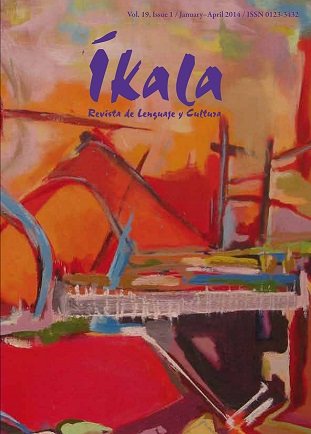Evaluación de las Llamadas Características Inflexionales Marcadas del Inglés Nigeriano: un Caso Relacionado con la Teoría de Adquisición de una Segunda Lengua
DOI:
https://doi.org/10.17533/udea.ikala.14303Palabras clave:
variantes del inglés, segunda lengua, inflexiones, interlenguajeResumen
Existen posturas contrarias entre los estudiosos con respecto a si las características estructurales de los tipos de inglés que se hablan en países donde éste se utiliza como segunda lengua les da el estatus de variante. Esta investigación analiza dichas características morfológicas consideradas como marcadas en el inglés que se habla en Nigeria tal y como lo establece Kirpatrick (2011) y la variante de inglés que se habla en Malaysia considerando los presupuestos de la Hipótesis de Inflexión Superficial Ausente (MSIH, por sus siglas en inglés), una teoría de adquisición de segunda lengua que da cuenta de la causa del uso variable de dichas inflexiones entre los aprendices de L2. Resultados de tareas de producción oral y escrita asignadas a estudiantes de pregrado de universidades en Nigeria y Malasia muestran que las que se consideran características morfológicas son de hecho desviaciones de las formas de la L2. De acuerdo a la MSIH, la variabilidad de tales inflexiones se debe a los problemas de recuperación léxica, un problema psicolingüístico que se manifiesta entre los aprendices de inglés como L2, dando generalmente como resultado representaciones superficiales erróneas.
Descargas
Citas
Adegbija, E. (1989). Lexico-semantic variation in Nigerian English, World Englishes. Vol. 8, No.2, pp. 165-177.
Adetugbo, A. (1979). Appropriateness in Nigerian English & Nigerian English and communicative competence. In E. Ubahakwe (Ed.), Varieties and functions of English in Nigeria, pp. 137-165 & 167-183 respectively. Ibadan: African Universities Press.
Alo, M., & Mesthrie, R. (2008). Nigerian English: morphology and syntax. In R. Mesthrie, (Ed.), Varieties of English, Africa, South and Southeast
Asia, (pp. 323-339). Berlin: Mouton de Gruyter.
Bamiro, E. (1991). Nigerian Englishes in Nigerian English literature, World Englishes. Vol. 10, No. 1, pp. 7-17.
Bamiro, E. (1991). The social and functional power of Nigerian English, World Englishes. Vol. 10, No. 3, pp. 275-286.
Battistella, E. L. (1990). Markedness: The evaluative superstructure of language. Albany, NY: SUNY Press.
Chomsky, N. (1986). Knowledge of language: its origin, nature and use. New York, Praeger.
Geckin, V., & Hazenadar, B. (2008). The morphology/ syntax interface in child L2 acquisition: evidence from verbal morphology. Current trends in child second language acquisition: A generative perspective. In B, Haznedar & E. Gavruseva (Eds.), 237-270. Amsterdam: John Benjamins.
Gut, U., & Fuchs. R. (2013). Progressive aspect in Nigerian English. Journal of English linguistics 41(3), 243-276.
Hazenadar, B. (2007). The acquisition of tense-aspect in child language English. Second Language Research 23, (4) 383-417.
Haznedar, B., & Schwartz, B. (1997). Are there optional infinitives in child L2 acquisition? In Proceedings of the 21st annual Boston University conference on language development. In E. Hughs, & A. Greenhill (Eds.), 257-268. Sommerville, MA: Cascadilla Press.
Ionin, T., & Wexler, K. (2002). Why is 'is' easier than '-s'? Acquisition of tense/agreement morphology by child second language learners of English. Second Language Research, 18, 95-136.
Jakobson, R. (1984). Shifters, verbal categories and the Russian verb. Selected writings, Vol. 2: Word and Language, 130-147. The Hague: Mouton.
Kachru, B. (1987). The alchemy of English: The speed, functions and models of non-native Englishes, World Englishes. Vol. 8, No. 2, pp.239-241. Reviewed. by J. Fishman.
Kachru, B. (1992a). World Englishes. In Language Teaching. Cambridge: Cambridge University Press.
Kirkpatrick, A. (2011). World Englishes. In J. Simpson (Ed.), Handbook of Applied Linguistics. London: Routledge: 373-387.
Kujore, O. (1985). English usage: Some notable Nigerian variations. Ibadan: Evans Brothers Ltd.
Lardiere, D. (1998a). Case and tense in fossilized steady state grammar. Second Language Research, 14, 1-26.
Lardiere, D. (1998b). Dissociating syntax from morphology in a divergent L2 end-state grammar. Second Language Research, 14, 359-375.
McCarthy, C. L. (2007). Morphological variability in second language Spanish. PhD Dissertation. Department of Linguistics McGill University Montreal Canada.
Ogu, J. (1992). A Historical survey of English and the Nigerian situation. Lagos: Krafts Books Ltd.
Omar, A. (Ed.). (2004). The Encyclopedia of Malaysia: Languages & literature. (9 Vol.). Michigan: Archipelago Press.
Prevost, P., & White, L. (2000). Missing surface inflection or impairment in second language acquisition? Evidence from tense and agreement. Second Language Research, 16, 103-133.
Roslie, T., & Ting, Su Hie, (1994). Malaysian English: Exploring the possibility of standardization. Perttanika Journal of social science and humanities, Vol, 2, (1). 69-76.
Selinker, L. (1972). Interlanguage. International Review of Applied Linguistics, 10, 209-231.
Salami, A. (1968). Defining a standard Nigerian English. Journal of the Nigerian English Studies Association (2)1, 99-106.
Slabakova, R. (2009). What is easy and what is hard to acquire in a second language. In Proceedings of the 10th generative approaches to second language acquisition conference. In M. Bowles, T. Ionin, S.
Montrul, & A. Tremblay, (Eds.), 280-294. Somerville, MA: Cascadilla Proceedings Project.
Walsh, N. (1967). Distinguishing types and varieties of English in Nigeria. Journal of the Nigerian English Studies Association (2)2, 47-55.
White, L, (2003). Second language acquisition and universal grammar. Cambridge University Press.
Descargas
Publicado
Cómo citar
Número
Sección
Licencia
Derechos de autor 2014 Íkala, Revista de Lenguaje y Cultura

Esta obra está bajo una licencia internacional Creative Commons Atribución-NoComercial-CompartirIgual 4.0.













